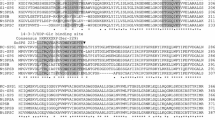Abstract
A full-length cDNA of Rubisco activase (IBrcaI) was cloned from sweet potato (Ipomoea batatas (L.) Lam) using Rapid-Amplification of cDNA Ends (RACE). IBrcaI contains a 1,347 bp open reading frame encoding a protein of 439 amino acids. The sequence alignment of multiple Rubisco activase genes from sweet potato and other plants showed high homology at two previously described ATP-binding sites. Western blot analysis indicated that there are two Rubisco activase proteins in sweet potato. Expression of IBrcaI was only detected in leaves. In the 14 h light and 10 h dark photoperiods, maximal and minimal IBrcaI mRNA expression levels were detected at 8:00 in the morning and at midnight, respectively.







Similar content being viewed by others
References
Portis AR Jr (2003) Rubisco activase-Rubsico;s catalytic chaperone. Photosynth Res 75:11–27. doi:10.1023/A:1022458108678
Walker JE, Saraste M, Runswick MJ, Gay NJ (1982) Distantly related sequences in the a- and b-subunits of ATP synthase, myosin, kinases and other ATP-requiring enzymes and a common nucleotide binding fold. EMBO J 1:945–951
Werneke JM, Chatfield JM, Ogren WL (1989) Alternative mRNA splicing generates the two Ribulosebisphosphate Carboxylase/oxygenase activase polypeptides in spinach and Arabidopsis. Plant Cell 1:815–825
Werneke JM, Zielinski RE, Ogren WL (1988) Structure and expression of spinach leaf cDNA encoding ribulosebisphosphate carboxylase/oxygenase activase. Proc Natl Acad Sci USA 85:787–791. doi:10.1073/pnas.85.3.787
Rundle SJ, Zielinski RE (1991) Organization and expression of two tandemlyoriented genes encoding ribulosebisphosphate carboxylase/oxygenase activase in barley. J Biol Chem 266:4677–4685
To KY, Suen DF, Chen SG (1999) Molecular characterization of ribulose-1,5-bisphosphate carboxylase/oxygenase activase in rice leaves. Planta 209:66–76. doi:10.1007/s004250050607
Salvucci ME, van de Loo FJ (2003) Two isoforms of Rubisco activase in cotton, the products of separate genes not alternative splicing. Planta 216:736–744
Salvucci ME, Werneke JM, Ogren WL, Portis AR Jr (1987) Purification and species distribution of Rubisco activase. Plant Physiol 84:930–936. doi:10.1104/pp.84.3.930
Law RD, Crafts-Brandner SJ (2001) High temperature stress increases the expression of wheat leaf ribulose bisphosphate carboxylase/oxygenase activase protein. Arch Biochem Biophys 386(2):261–267. doi:10.1006/abbi.2000.2225
Crafts-Brandner SJ, Salvucci ME (2002) Sensitivity of photosynthesis in a C4 plant, maize, to heat stress. Plant Physiol 129:1773–1780. doi:10.1104/pp.002170
Roesler KR, Ogren WL (1990) Primary structure of Chlamydomonas reinhardtii Ribulose-1,5-bisphosphate carboxylase/oxygenase activase and evidence for a single polypeptide. Plant Physiol 94:1837–1841. doi:10.1104/pp.94.4.1837
Ohara O, Dorit RL, Gilbert W (1983) One-side polymerase chain reaction: the amplification of cDNA. Proc Natl Acad Sci USA 86:5673–5677. doi:10.1073/pnas.86.15.5673
Mahmoud SS, Wang SL, Moloney MM, Habibi HR (1998) Production of a biologically active novel goldfish growth hormone in Escherichia coli. Comp Biochem Physiol B 120:657–663. doi:10.1016/S0305-0491(98)10059-7
Robinson SP, Streusand VJ, Chatfield JM, Portis AR Jr (1988) Purification and assay of Rubisco activase from leaves. Plant Physiol 88:1008–1014. doi:10.1104/pp.88.4.1008
Li CS, Salvucci ME, Portis AR Jr (2005) Two residues of Rubisco activase involved in recognition of the Rubisco substrate. J Biochem 280:24864–24869
Li CS, Wang DF, Portis AR Jr (2006) Identification of critical arginine residues in the functioning of Rubisco activase. Arch Biochem Biophys 450:176–182. doi:10.1016/j.abb.2006.04.002
Wang DF, Portis AR Jr (2006) Two conserved tryptophan residues are responsible for intrinsic fluorescence enhancement in Rubsico activase upon ATP binding. Photosynth Res 88:185–193. doi:10.1007/s11120-006-9051-2
Zielinski RE, Werneke JM, Jenkins ME (1989) Coordinate expression of Rubisco activase and Rubisco during barley leaf cell development. Plant Physiol 90:516–521. doi:10.1104/pp.90.2.516
Author information
Authors and Affiliations
Corresponding author
Rights and permissions
About this article
Cite this article
Xu, K., He, B., Zhou, S. et al. Cloning and characterization of the Rubisco activase gene from Ipomoea batatas (L.) Lam. Mol Biol Rep 37, 661–668 (2010). https://doi.org/10.1007/s11033-009-9510-x
Received:
Accepted:
Published:
Issue Date:
DOI: https://doi.org/10.1007/s11033-009-9510-x




